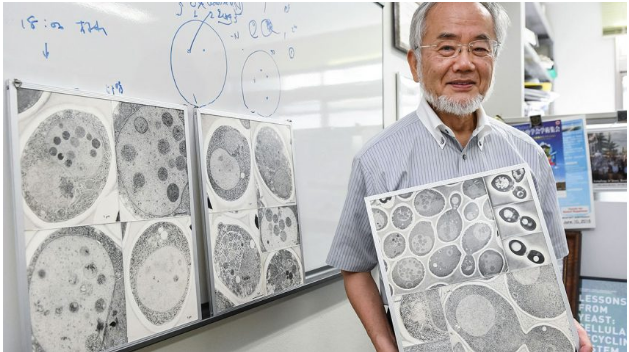Japanese cell biologist Yoshinori Ohsumi has been awarded this year’s Nobel Prize in Physiology or Medicine for his discoveries on how the body’s cells digest and recycle their organelles, a process that plays an important role in cancer, diabetes, Huntington’s disease and numerous other diseases. This highly-organized mechanism is called autophagy, the Greek term for “self eating.”
In the 1960s, researchers observed that some animal cells used autophagy to recycle cellular machinery and reuse them for energy. They noted that this process was especially active during periods of stress, including starvation or infection. Studying this internal recycling program proved to be difficult and little was known about this phenomenon until Ohsumi began studying this process in baker’s yeast in the 1990s.
Ohsumi and his colleagues first developed a series of experiments to observe what happened to these singlecelled organisms when autophagy failed. “I thought of trying something others weren’t working on, so I started research into yeast,” he explained at the press conference on the campus of the Tokyo Institute of Technology.
To determine what biological processes were involved in autophagy, Ohsumi and his lab systematically removed candidate genes in yeast using genome engineering techniques. By seeing how the loss of certain genes affected how the cell recycles its organelles, they were able to determine the exact biological mechanism of autophagy.
Specifically, they developed different strains of yeast that lacked key enzymes thought to be associated with autophagy. When his team stimulated autophagy by starving the yeast, they noticed that cells with functioning autophagy developed unusually large vacuoles, organelles that hold waste, compared to the mutated cells with disrupted autophagy. In healthy yeast cells, these vacuoles are typically too small to be observed using a light microscope, but in mutant cells, these vacuoles can be easily identified.
His findings not only proved that autophagy exists in yeast cells, but also provided him with a method to identify the genes involved in the mechanism. Ohsumi introduced random mutations in the yeast cells by exposing them to a chemical and then induced autophagy by exposing the cells to starvation conditions. By studying mutants that were unable to form visible vacuoles, Ohsumi and his team were able to identify and functionally characterize 15 genes essential for autophagy.
Since the genes necessary for autophagy and its associated metabolic pathways in yeast are also conserved in higher organisms, Ohsumi was able to subsequently describe how autophagy works in humans and other animals.
A press release by the Nobel Assembly stated “Ohsumi’s discoveries led to a new paradigm in our understanding of how the cell recycles its content. His discoveries opened the path to understanding the fundamental importance of autophagy in many physiological processes.”
Ohsumi’s discoveries have helped to explain how the human body adapts to starvation and other extreme physiological conditions. Disrupted autophagy has been linked to multiple diseases, including numerous cancers, diabetes and Parkinson’s disease. Most importantly, his findings pave the way for the development of new therapies that target processes in autophagy in various diseases.
“Of course for a researcher, there is no higher honor,” Ohsumi said of the decision to award him the Nobel Prize at his press conference. He humbly added that he was “lucky” to make the discovery early on in his career. “This recycling process did not receive as much attention as it deserved, but I discovered that we should be paying more attention to this autophagy process.”
When Ohsumi was asked if he had a message for burgeoning young scientists, he challenged them to try getting involved. “I’d like to tell young people that not all can be successful in science, but it’s important to rise to the challenge,” Ohsumi said.







